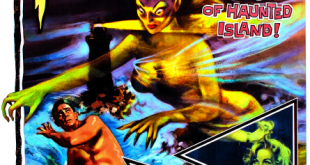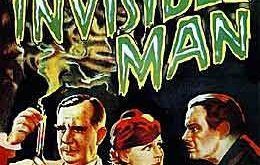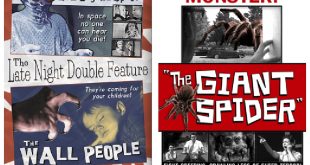 SYNOPSIS:
SYNOPSIS:
“In the mid-fifties, American scientists determine that they require metal from meteors if they are to build spacecraft that can withstand the rigors of space travel. To that end they recruit twelve scientists and ask them to undergo a series of tests. The men don’t quite know exactly what they are being tested for but in the end, three are selected to go into space. Their mission is to capture a meteor and bring it to Earth. The mission is a success, but not all will return.” (courtesy IMDB)
REVIEW:
Hungarian scriptwriter Ivan Tors moved to America just before the outbreak of World War Two, joining the United States Army’s Office of Strategic Services. Soon after the war he was hired by Metro-Goldwyn-Mayer as a screenwriter and, by the early fifties, became famous for producing exciting non-violent feature films and television shows, many set in space or under the sea. A long-time fan of ‘hard’ science fiction, Tors formed a production company called A-Men Films with actor Richard Carlson, devoted to making TV series like Science Fiction Theatre, Sea Hunt, The Aquanauts and Ripcord, as well as three movies collectively known as the Office of Scientific Investigation (OSI) Trilogy: The Magnetic Monster (1951), Gog (1954) and Riders To The Stars (1954).
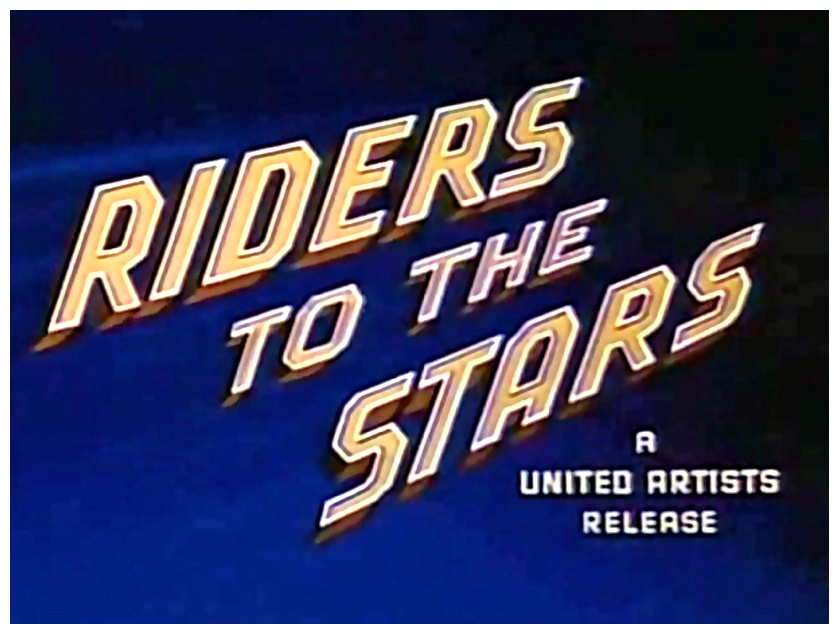 Films that dealt realistically with the possibilities of space travel – like Destination Moon (1950) – were rare during the fifties, but the various productions of Ivan Tors demonstrated an obvious interest in real working technology, and actively avoided the more sensational clichés endemic to the medium. Unfortunately the end result is (like Destination Moon before it) terribly dull when viewed today, the only interest being provided by the special photographic effects by Harry Redmond and Jack Glass. Tors hired horror scriptwriter Curt Siodmak (someone who has never shown any empathy for science) to write a screenplay based on a totally illogical concept, making this one of the silliest science fiction films ever. Paradoxically, this gives Riders To The Stars a high entertainment value for anyone who is scientifically literate, a veritable laugh-a-minute comedy.
Films that dealt realistically with the possibilities of space travel – like Destination Moon (1950) – were rare during the fifties, but the various productions of Ivan Tors demonstrated an obvious interest in real working technology, and actively avoided the more sensational clichés endemic to the medium. Unfortunately the end result is (like Destination Moon before it) terribly dull when viewed today, the only interest being provided by the special photographic effects by Harry Redmond and Jack Glass. Tors hired horror scriptwriter Curt Siodmak (someone who has never shown any empathy for science) to write a screenplay based on a totally illogical concept, making this one of the silliest science fiction films ever. Paradoxically, this gives Riders To The Stars a high entertainment value for anyone who is scientifically literate, a veritable laugh-a-minute comedy.
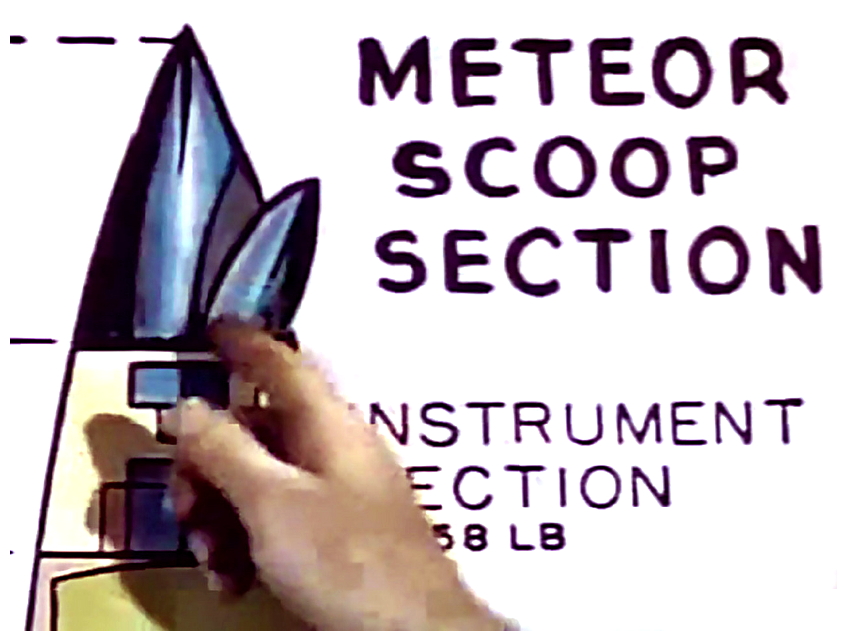 We are told that cosmic rays make space travel dangerous because they destroy metals outside the Earth’s atmosphere, but meteors make it safely to Earth, therefore meteors must be coated with a substance that deflects cosmic rays. The plan is to capture a meteor before it enters the Earth’s atmosphere to discover exactly what this protective quality consists of, then attempt to duplicate it on the hulls of spaceships (meteors, of course, do disintegrate when they hit the air, and it’s only the remains of the very large ones that reach the ground). From a dozen recruits, three astronauts are chosen to go up in rockets with great big scoops and catch some meteors, thus saving the space program.
We are told that cosmic rays make space travel dangerous because they destroy metals outside the Earth’s atmosphere, but meteors make it safely to Earth, therefore meteors must be coated with a substance that deflects cosmic rays. The plan is to capture a meteor before it enters the Earth’s atmosphere to discover exactly what this protective quality consists of, then attempt to duplicate it on the hulls of spaceships (meteors, of course, do disintegrate when they hit the air, and it’s only the remains of the very large ones that reach the ground). From a dozen recruits, three astronauts are chosen to go up in rockets with great big scoops and catch some meteors, thus saving the space program.
 The film carefully and soberly documents the various attempts by the astronauts (including William Lundigan, Richard Carlson, King Donovan and Robert Karnes) to capture a meteor and – after many grim-jawed heroics, various mishaps and a couple of fatalities – they finally succeed. It turns out that meteors are protected by a layer of carbon and diamond dust which burns away as the meteor hurtles through the atmosphere, leaving the inner core untouched. Another miraculous breakthrough for pseudo-science, hurrah! Riders To The Stars is absurd on so many levels you’d think it impossible to list them all but, what the hey, I’ll give it a go:
The film carefully and soberly documents the various attempts by the astronauts (including William Lundigan, Richard Carlson, King Donovan and Robert Karnes) to capture a meteor and – after many grim-jawed heroics, various mishaps and a couple of fatalities – they finally succeed. It turns out that meteors are protected by a layer of carbon and diamond dust which burns away as the meteor hurtles through the atmosphere, leaving the inner core untouched. Another miraculous breakthrough for pseudo-science, hurrah! Riders To The Stars is absurd on so many levels you’d think it impossible to list them all but, what the hey, I’ll give it a go:
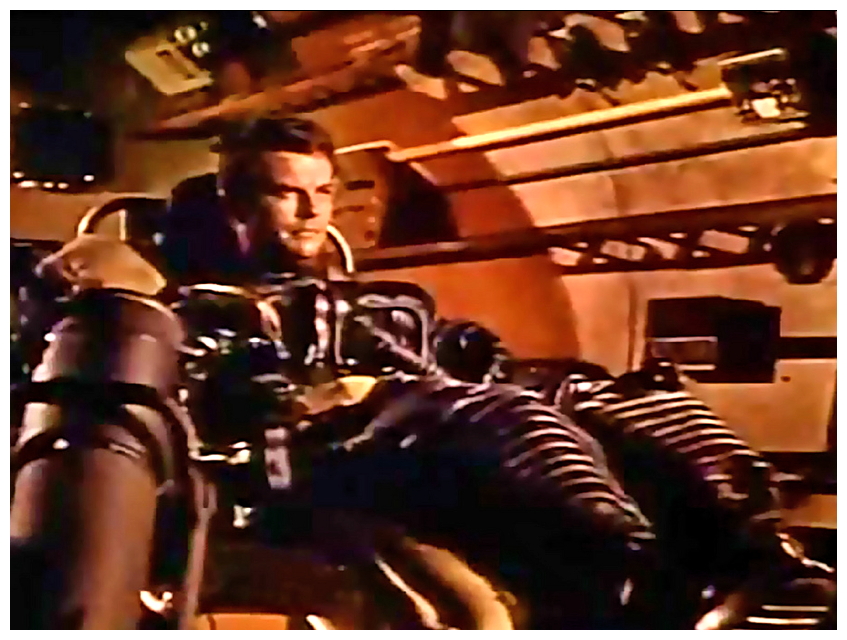 One, the basic premise – cosmic rays crystallising and crushing metal in space, yet meteors remain unaffected – is quite ridiculous. Cosmic rays do not crystallise or in any way affect any substance in space, on Earth or anywhere else for that matter. This was a well-known fact, even sixty years ago. Two, at one point an astronaut (Robert Karnes) is expelled from his ship, exposed to the vacuum of space and instantly turns into a decayed skeleton (Nigel Honeybone). I tried explaining to director Richard Carlson that the vacuum of space would instantly kill not only the astronaut, but also the microorganisms within the astronaut that cause decay, so a victim of this kind of accident should look exactly as they did in life, frozen indefinitely, but he refused to heed my sage advice and carried on regardless.
One, the basic premise – cosmic rays crystallising and crushing metal in space, yet meteors remain unaffected – is quite ridiculous. Cosmic rays do not crystallise or in any way affect any substance in space, on Earth or anywhere else for that matter. This was a well-known fact, even sixty years ago. Two, at one point an astronaut (Robert Karnes) is expelled from his ship, exposed to the vacuum of space and instantly turns into a decayed skeleton (Nigel Honeybone). I tried explaining to director Richard Carlson that the vacuum of space would instantly kill not only the astronaut, but also the microorganisms within the astronaut that cause decay, so a victim of this kind of accident should look exactly as they did in life, frozen indefinitely, but he refused to heed my sage advice and carried on regardless.
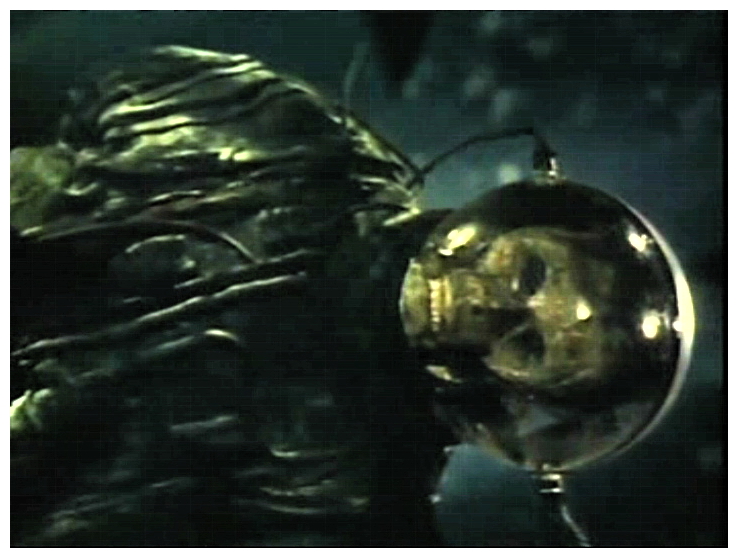 Three, while one of the astronauts is spinning around in a centrifuge we see an X-ray of his chest showing his heart reversed left to right. You’d probably dismiss this as a simple editing mistake, until a doctor announces that the astronaut’s body temperature is 135 degrees Fahrenheit (57.2 degrees Celsius in newspeak), which is incompatible with life as we know it. Four, as the last rocket returns to Earth with its precious cargo, its altitude is first reported as 12,000 feet, then 5,000 feet, yet both times we see the rocket is still in space. When we see the rocket finally entering the atmosphere we are told it is at an altitude of 1,000 feet. Most children with a basic interest in space are well-aware that the outermost edge of space is more than 100,000 feet (30.5 kilometres in newspeak) above the Earth’s surface.
Three, while one of the astronauts is spinning around in a centrifuge we see an X-ray of his chest showing his heart reversed left to right. You’d probably dismiss this as a simple editing mistake, until a doctor announces that the astronaut’s body temperature is 135 degrees Fahrenheit (57.2 degrees Celsius in newspeak), which is incompatible with life as we know it. Four, as the last rocket returns to Earth with its precious cargo, its altitude is first reported as 12,000 feet, then 5,000 feet, yet both times we see the rocket is still in space. When we see the rocket finally entering the atmosphere we are told it is at an altitude of 1,000 feet. Most children with a basic interest in space are well-aware that the outermost edge of space is more than 100,000 feet (30.5 kilometres in newspeak) above the Earth’s surface.
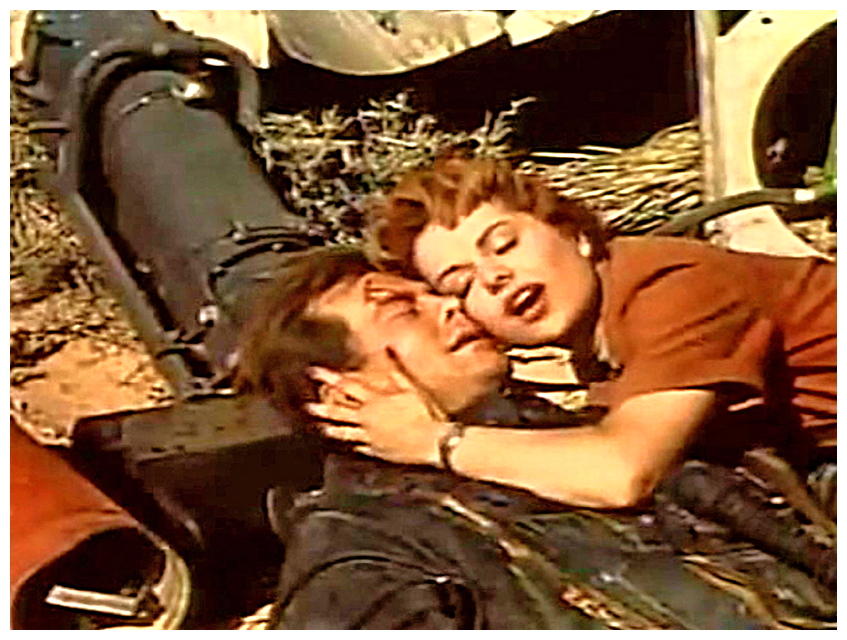 In the sixties Ivan Tors moved away from science fiction to produce several films and television shows featuring exotic animals and locales, like Flipper (1963), Clarence The Cross-Eyed Lion (1965), Rhino! (1965), Zebra In The Kitchen (1965) and Africa Texas Style (1967). He was hired by Cubby Broccoli to produce the underwater action sequence for the popular James Bond film Thunderball (1965) while making his own films Around The World Under The Sea (1966) and a particularly cheesy favourite of mine, Hello Down There (1969), with a rather incredible cast including Tony Randall, Ken Berry, Jim Backus, Janet Leigh, Roddy McDowall, Charlotte Rae, Richard Dreyfuss, Arnold Stang, Harvey Lembeck and Merv Griffin, but that’s another story for another time. At this point I’ll ask you to join me again next week when I’ll have another opportunity to inflict upon you the tortures of the damned from that dank bottomless pit formerly known as Hollywoodland for…Horror News! Toodles!
In the sixties Ivan Tors moved away from science fiction to produce several films and television shows featuring exotic animals and locales, like Flipper (1963), Clarence The Cross-Eyed Lion (1965), Rhino! (1965), Zebra In The Kitchen (1965) and Africa Texas Style (1967). He was hired by Cubby Broccoli to produce the underwater action sequence for the popular James Bond film Thunderball (1965) while making his own films Around The World Under The Sea (1966) and a particularly cheesy favourite of mine, Hello Down There (1969), with a rather incredible cast including Tony Randall, Ken Berry, Jim Backus, Janet Leigh, Roddy McDowall, Charlotte Rae, Richard Dreyfuss, Arnold Stang, Harvey Lembeck and Merv Griffin, but that’s another story for another time. At this point I’ll ask you to join me again next week when I’ll have another opportunity to inflict upon you the tortures of the damned from that dank bottomless pit formerly known as Hollywoodland for…Horror News! Toodles!
 Horror News | HNN Official Site | Horror Movies,Trailers, Reviews
Horror News | HNN Official Site | Horror Movies,Trailers, Reviews

